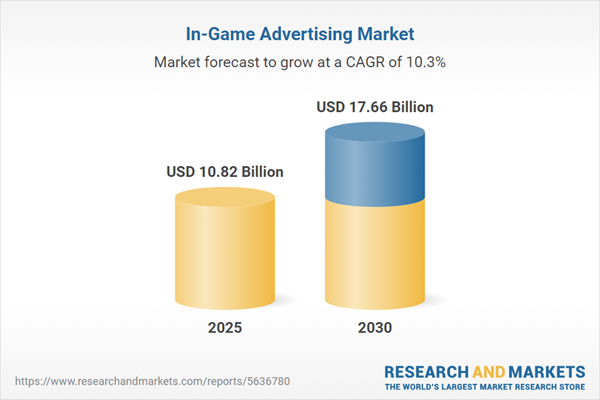The In-Game Advertising Market, valued at US$10.822 billion in 2025, is projected to grow at a CAGR of 10.29%, reaching a market size of US$17.658 billion by 2030.
The In-Game advertising market is anticipated to grow significantly during the forecast period due to the rising popularity of video games, offering a perfect space for advertisers to promote their products or services. The surge in mobile gaming due to the widespread adoption of smartphones and faster internet connectivity is driving the in-game advertising market. Moreover, the increase in demand from advertisers' targeted ad placements is also boosting the market expansion.
The In-Game advertising market is anticipated to grow significantly during the forecast period due to the rising popularity of video games, offering a perfect space for advertisers to promote their products or services. The surge in mobile gaming due to the widespread adoption of smartphones and faster internet connectivity is driving the in-game advertising market. Moreover, the increase in demand from advertisers' targeted ad placements is also boosting the market expansion.
Market Trends:
- Expanding Opportunities for In-Game Advertising in Mobile Gaming: The rising popularity of smartphones and handheld devices has turned mobile gaming into a massive market, offering users the convenience of playing games anytime, anywhere. According to the Interactive Advertising Bureau, two-thirds of the U.S. population engages in video gaming, highlighting the vast potential for in-game advertising.
- Rising Investments in In-Game Advertising: Increased funding in the in-game advertising sector is driving market growth, enabling the creation of more interactive and immersive ad experiences. For example, Admix raised $25 million to enhance its in-game advertising platform, opening up new opportunities for advertisers.
- Shift Toward Non-Intrusive Ads: To overcome the challenge of disruptive ads, the industry is moving toward non-intrusive advertising formats. These ads seamlessly blend into the gaming experience without interrupting gameplay, a trend expected to propel the in-game advertising market during the forecast period.
- Asia-Pacific’s Growth Potential: The Asia-Pacific region is poised for significant growth in the in-game advertising market, driven by its status as the largest gaming market globally. Countries like India, China, and Southeast Asia are witnessing a surge in mobile gaming demand. The region’s growing economies and diverse demographics are fueling the integration of advertising into its booming gaming industry.
- North America’s Market Leadership: North America holds a substantial share of the in-game advertising market, supported by a strong gaming industry and the presence of key players like Admix and Bidstack. These companies are pioneering advanced advertising technologies, further solidifying the region’s market dominance.
Key Benefits of this Report:
- Insightful Analysis: Gain detailed market insights covering major as well as emerging geographical regions, focusing on customer segments, government policies and socio-economic factors, consumer preferences, industry verticals, and other sub-segments.
- Competitive Landscape: Understand the strategic maneuvers employed by key players globally to understand possible market penetration with the correct strategy.
- Market Drivers & Future Trends: Explore the dynamic factors and pivotal market trends and how they will shape future market developments.
- Actionable Recommendations: Utilize the insights to exercise strategic decisions to uncover new business streams and revenues in a dynamic environment.
- Caters to a Wide Audience: Beneficial and cost-effective for startups, research institutions, consultants, SMEs, and large enterprises.
What can businesses use this report for?
Industry and Market Insights, Opportunity Assessment, Product Demand Forecasting, Market Entry Strategy, Geographical Expansion, Capital Investment Decisions, Regulatory Framework & Implications, New Product Development, Competitive Intelligence.Report Coverage:
- Historical data from 2022 to 2024 & forecast data from 2025 to 2030
- Growth Opportunities, Challenges, Supply Chain Outlook, Regulatory Framework, and Trend Analysis
- Competitive Positioning, Strategies, and Market Share Analysis
- Revenue Growth and Forecast Assessment of segments and regions including countries
- Company Profiling (Strategies, Products, Financial Information, and Key Developments among others)
In-Game Advertising Market is analyzed into the following segments:
By Ad Type
- Static Ads
- Dynamic Ads
- Advergaming
By Game Type
- PC/Laptop Games
- Console Games
- Smartphone/ Tablet Games
By Region
- North America
- Europe
- Asia Pacific
- South America
- Middle East & Africa
Table of Contents
1. INTRODUCTION
2. RESEARCH METHODOLOGY
3. EXECUTIVE SUMMARY
4. MARKET DYNAMICS
5. IN-GAME ADVERTISING MARKET BY AD TYPE
6. IN-GAME ADVERTISING MARKET BY GAME TYPE
7. IN-GAME ADVERTISING MARKET BY GEOGRAPHY
8. COMPETITIVE ENVIRONMENT AND ANALYSIS
9. COMPANY PROFILES
10. APPENDIX
Companies Mentioned
- Admix
- Bidstack Limited
- Adverty AB
- Rapidfire, Inc.
- Playwire
- Gamelin
- Engage
- ironSource
Methodology

LOADING...
Table Information
| Report Attribute | Details |
|---|---|
| No. of Pages | 145 |
| Published | March 2025 |
| Forecast Period | 2025 - 2030 |
| Estimated Market Value ( USD | $ 10.82 Billion |
| Forecasted Market Value ( USD | $ 17.66 Billion |
| Compound Annual Growth Rate | 10.2% |
| Regions Covered | Global |









